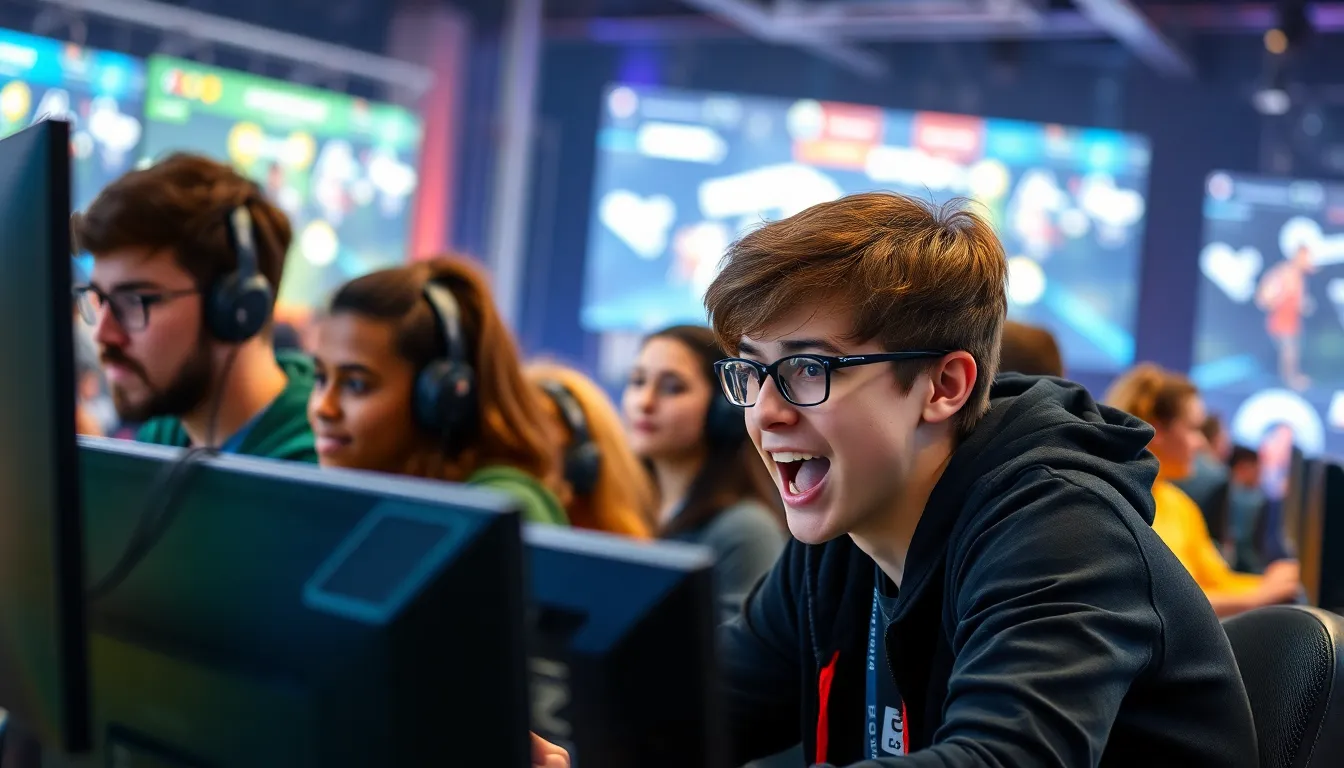Table of Contents
ToggleIn the high-stakes world of CS2, the pistol round isn’t just a warm-up; it’s a chance to flex those tactical muscles and set the tone for the entire match. Picture this: a team of eager players, armed with nothing but their trusty pistols and a sprinkle of strategy, ready to outsmart their opponents. It’s like a game of chess, but with more adrenaline and fewer pawns.
Mastering pistol round tactics can turn the tide in your favor faster than you can say “eco round.” Whether you’re a seasoned veteran or a fresh recruit, understanding how to position yourself and your team can make all the difference. So grab your favorite sidearm, and get ready to dive into some clever tactics that’ll have your opponents scratching their heads and you racking up those sweet, sweet kills.
Overview of CS2 Pistol Round Tactics
Pistol rounds play a crucial role in CS2, allowing teams to set the tone for their matches. Establishing a strong sequence right from the start helps maintain momentum. Employing decisive strategies can lead to significant advantages over opponents.
Effective communication among team members remains vital during this phase. Coordinated attacks can overwhelm opponents before they gain footing. Focusing on map control enables teams to dictate the pace of the round. Flanking routes often catch enemies off-guard and create openings for swift eliminations.
Utilizing positioning enhances overall effectiveness. Players positioned strategically can provide crucial support and cover. Aggressive pushes can overpower less prepared opponents, while defense-based tactics can exploit enemy mistakes.
Analyzing the enemy’s approach offers additional insights. Identifying patterns in tactics allows teams to respond accordingly. Adapting to opponent strategies provides an edge throughout the round. Maintaining awareness of teammate positions fosters collaboration and improves chances of survival.
Choosing the right pistols based on team strategy is equally essential. The P250, for example, offers high damage output but requires accurate shots. Meanwhile, the Glock provides a higher rate of fire, making it effective in close quarters.
Planning the economy around pistol rounds contributes significantly to future rounds. Winning the pistol round can secure the overall financial advantage needed for later stages. Making wise purchases ensures sustained competitive capability throughout the match.
Key Strategies for Success

Mastering the pistol round requires a mix of aggression and strategy. Players must decide on their approach based on team dynamics and map conditions.
Aggressive Playstyle
An aggressive playstyle emphasizes rush tactics. This approach seeks immediate map control and forces enemies to react quickly. Players can split into groups, overwhelming opponents with sheer numbers. Prioritizing communication ensures each teammate knows their target and position. Using flashbangs effectively disorients enemies, creating openings for quick kills. Rushing key locations like bomb sites puts pressure on defenders, making them vulnerable. Challenging opponents right away can intimidate enemies and set the tone for the game. Individuals should remain aware of flanking routes to evade counterattacks. This high-pressure strategy can turn the tide in early rounds.
Passive Playstyle
A passive playstyle focuses on careful positioning and patience. Players hold angles to catch opponents off guard without committing to aggressive engagements. This method allows teams to gather intel about enemy movements while minimizing risks. Utilizing utility effectively, players can force enemies into unfavorable positions. Strong team coordination is vital, as it enables synchronized responses to threats. Players should maintain a close watch on flanking routes to secure team safety. By waiting for enemies to make mistakes, this strategy capitalizes on overextensions or poor decisions. Patience often pays off, leading to opportunities for strategic picks and eventual control of the game.
Map-Specific Tactics
Map-specific tactics play a vital role in maximizing effectiveness during pistol rounds in CS2. Teams should adapt strategies based on the unique layouts and features of each site.
A-Site Strategies
Control of A-site requires a well-coordinated approach. Players can start by sending a few teammates through A main while others flank from A short. Utilizing utility, such as smoke grenades, helps obscure enemy sightlines. Quick movement into site allows players to plant the bomb, securing a strong position. Keeping an eye on both A ramp and Tetris is essential to guard against flanking enemies. Communication remains crucial; sharing enemy positions fosters a unified response. Taking precise angles increases the chances to catch opponents off-guard, creating opportunities for elimination.
B-Site Strategies
To execute on B-site effectively, teams should divide their forces. A common tactic involves one group pushing through B tunnels and another applying pressure from mid. Smoke and flashbangs can disorient defenders, allowing for a swift entry. Establishing control over B site involves prioritizing essential chokepoints like B doors and CT spawn. Holding these areas while planting the bomb creates defensible positions. Effective crossfire setups discourage enemy retakes. Regularly sharing information on enemy movements aids in adapting strategies quickly, ensuring the team maintains the upper hand.
Utility Usage in Pistol Rounds
Effective utility usage during pistol rounds provides teams with a tactical edge. Players can leverage utility to control engagements by utilizing smokes and flashes to obscure vision and create openings.
Smokes and Flashes
Smokes serve to block sightlines, hindering enemy visibility during engagements. Teams executing A-site strategies can use smoke to cover chokepoints like A main or A short. Flashbangs, on the other hand, temporarily blind opponents, making them vulnerable. Coordinating flashbang throws can lead to successful site entries by overwhelming defenders. Players positioned at key angles can capitalize on these distractions, helping the team secure map control. Combining both smokes and flashes fosters opportunities for pushing and taking critical positions with minimal resistance.
Molotovs and Decoys
Molotovs effectively deny areas, forcing opponents from strong positions. By deploying a Molotov at common hiding spots, teams can clear out defenders during site takes. On B-site pushes, using Molotovs in B tunnels can disrupt enemy positioning and create confusion. Decoys can mimic gunfire sounds, diverting attention away from actual player movements. When strategically placed, decoys help teams execute unexpected flanks or pushes. Utilizing these utilities effectively maximizes the chances of achieving favorable engagements and securing objectives in critical pistol rounds.
Team Coordination and Communication
Effective team coordination and communication play crucial roles in winning pistol rounds. Players must actively share information about enemy positions and potential strategies. Clear calls about movement and engagement can turn the tide of an encounter. Each team member should focus on their assigned roles while remaining flexible to adapt to evolving situations.
Establishing a call-out system for key areas on the map enhances communication efficiency. This allows teammates to react quickly to unfolding events. Sharing information about enemy flanks or suggesting alternative tactics can bolster overall team performance. Additionally, players should discuss their intended strategies during the buy phase, ensuring everyone is aligned before executing their plan.
Utilizing voice chat or in-game markers increases clarity during fast-paced engagements. Quick instructions, such as “rush B” or “flank A,” empower teammates to act decisively. Adopting a common language facilitates smoother interactions, especially under pressure. Regular discussions about preferred communication styles can further streamline teamwork.
Teams that practice together often develop a better understanding of each other’s playstyles. Familiarity fosters trust, enabling players to take risks without fear of leaving teammates exposed. Participating in scrims allows teams to refine their strategies and build effective communication habits. Over time, these practices create an environment where players instinctively react to the needs of the team.
Overall, strong coordination and communication define the effectiveness of pistol rounds. Leveraging collective strengths can lead to overwhelming opponents and gain control of critical map areas. Prioritizing these elements ensures a unified approach, maximizing the chances of securing victory early in the match.
Mastering pistol round tactics is crucial for setting the stage in CS2. Effective communication and strategic positioning can make all the difference in gaining early momentum. Players should focus on adapting their strategies based on map specifics and enemy movements while utilizing utility to enhance their effectiveness.
Choosing the right playstyle—whether aggressive or passive—can dictate the flow of the match. By coordinating attacks and maintaining awareness of team dynamics, players can capitalize on opportunities and secure control of key areas. With practice and a solid understanding of tactics, teams can significantly improve their chances of victory from the very first round.

